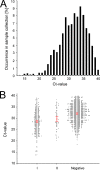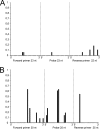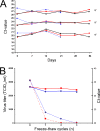Practical considerations for high-throughput influenza A virus surveillance studies of wild birds by use of molecular diagnostic tests
- PMID: 19109483
- PMCID: PMC2650931
- DOI: 10.1128/JCM.01625-08
Practical considerations for high-throughput influenza A virus surveillance studies of wild birds by use of molecular diagnostic tests
Abstract
Influenza A virus surveillance studies of wild bird populations are essential to improving our understanding of the role of wild birds in the ecology of low-pathogenic avian influenza viruses and their potential contribution to the spread of H5N1 highly pathogenic avian influenza viruses. Whereas the primary results of such surveillance programs have been communicated extensively, practical considerations and technical implementation options generally receive little attention. In the present study, the data obtained from 39,490 samples were used to compare the impacts of variables such as the sampling procedure, storage and transport conditions, and the choice of molecular and classical diagnostic tests on the outcome of the results. Molecular diagnostic tests allowed estimation of the virus load in samples, which has implications for the ability to isolate virus. Virus isolation in embryonated eggs was more sensitive than virus isolation in cell cultures. Storage and transport conditions had less of an impact on diagnostics by the use of molecular tests than by the use of classical approaches. These findings indicate that molecular diagnostic tests are more sensitive and more reliable than classical tests. In addition, molecular diagnostic tests facilitated analyses in real time and allowed the discrimination of H5 influenza viruses with low and high pathogenicities without the need for virus isolation. Critical assessment of the methods used in large surveillance studies like this will facilitate comparison of the results between studies. Moreover, the lessons learned from current large-scale influenza A virus surveillance activities could be valuable for other pathogen surveillance programs in the future.
Figures





Similar articles
-
How Does Sampling Methodology Influence Molecular Detection and Isolation Success in Influenza A Virus Field Studies?Appl Environ Microbiol. 2015 Dec 11;82(4):1147-1153. doi: 10.1128/AEM.03283-15. Print 2016 Feb 15. Appl Environ Microbiol. 2015. PMID: 26655759 Free PMC article.
-
Single and combination diagnostic test efficiency and cost analysis for detection and isolation of avian influenza virus from wild bird cloacal swabs.Avian Dis. 2010 Mar;54(1 Suppl):606-12. doi: 10.1637/8838-040309-Reg.1. Avian Dis. 2010. PMID: 20521702
-
Surveillance of avian influenza viruses in South Korea between 2012 and 2014.Virol J. 2017 Mar 14;14(1):54. doi: 10.1186/s12985-017-0711-y. Virol J. 2017. PMID: 28292308 Free PMC article.
-
Molecular diagnosis of avian influenza during an outbreak.Dev Biol (Basel). 2006;124:99-105. Dev Biol (Basel). 2006. PMID: 16447500 Review.
-
Epidemiology of low pathogenic avian influenza viruses in wild birds.Rev Sci Tech. 2009 Apr;28(1):49-58. doi: 10.20506/rst.28.1.1863. Rev Sci Tech. 2009. PMID: 19618618 Review.
Cited by
-
Attachment Patterns of Human and Avian Influenza Viruses to Trachea and Colon of 26 Bird Species - Support for the Community Concept.Front Microbiol. 2019 Apr 18;10:815. doi: 10.3389/fmicb.2019.00815. eCollection 2019. Front Microbiol. 2019. PMID: 31057520 Free PMC article.
-
Concentrations and size distributions of airborne influenza A viruses measured indoors at a health centre, a day-care centre and on aeroplanes.J R Soc Interface. 2011 Aug 7;8(61):1176-84. doi: 10.1098/rsif.2010.0686. Epub 2011 Feb 7. J R Soc Interface. 2011. PMID: 21300628 Free PMC article.
-
Intestinal excretion of a wild bird-origin H3N8 low pathogenic avian influenza virus in mallards (Anas Platyrhynchos).J Wildl Dis. 2012 Oct;48(4):991-8. doi: 10.7589/2011-09-280. J Wildl Dis. 2012. PMID: 23060500 Free PMC article.
-
Novel Zoonotic Avian Influenza A(H3N8) Virus in Chicken, Hong Kong, China.Emerg Infect Dis. 2022 Oct;28(10):2009-2015. doi: 10.3201/eid2810.221067. Epub 2022 Aug 29. Emerg Infect Dis. 2022. PMID: 36037827 Free PMC article.
-
Location, Age, and Antibodies Predict Avian Influenza Virus Shedding in Ring-Billed and Franklin's Gulls in Minnesota.Animals (Basel). 2024 Sep 26;14(19):2781. doi: 10.3390/ani14192781. Animals (Basel). 2024. PMID: 39409730 Free PMC article.
References
-
- Alexander, D. J. 2000. A review of avian influenza in different bird species. Vet. Microbiol. 743-13. - PubMed
-
- Chen, H., G. J. Smith, S. Y. Zhang, K. Qin, J. Wang, K. S. Li, R. G. Webster, J. S. Peiris, and Y. Guan. 2005. Avian flu: H5N1 virus outbreak in migratory waterfowl. Nature 436191-192. - PubMed
Publication types
MeSH terms
Grants and funding
LinkOut - more resources
Full Text Sources
Medical

